Hole in the Earth

A meteorite that rocked the Sahara desert over 300 million years ago left behind quite a scar that's been photographed before.
New satellite images released by NASA this week provide a closer view of the Aorounga Impact Crater in north-central Chad, one of the best preserved impact structures in the world.
The crater measures 10 miles (17 kilometers) across with a peak that is surrounded by a small sand-filled trough. This feature is surrounded by an even larger circular trough. Winds at the site blow from the northeast and sand dunes formed between the ridges are actively migrating to the southwest. Measuring 10 miles (17 kilometers) across,
In 1994, Spaceborne Imaging Radar (SIR) found evidence that the Aorounga crater may likely be one of a set of three craters formed by the same impact event. The other two craters are thought to have been buried by sand deposits. Scientists suspect the possible crater "chain" might have been formed when the mile long object broke apart before impact.
Get the world’s most fascinating discoveries delivered straight to your inbox.



